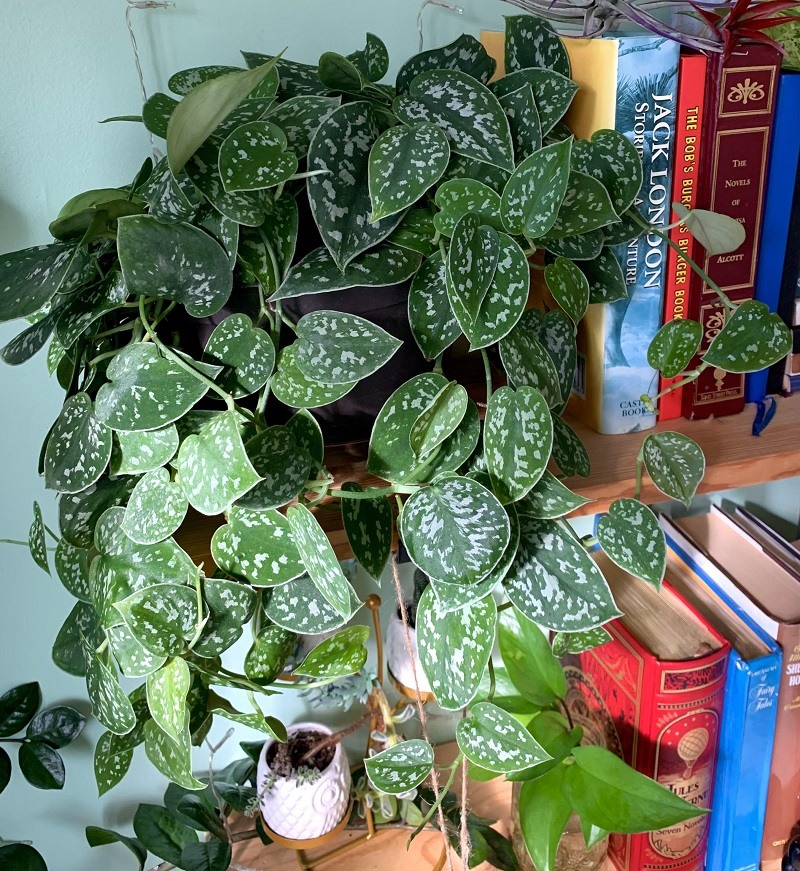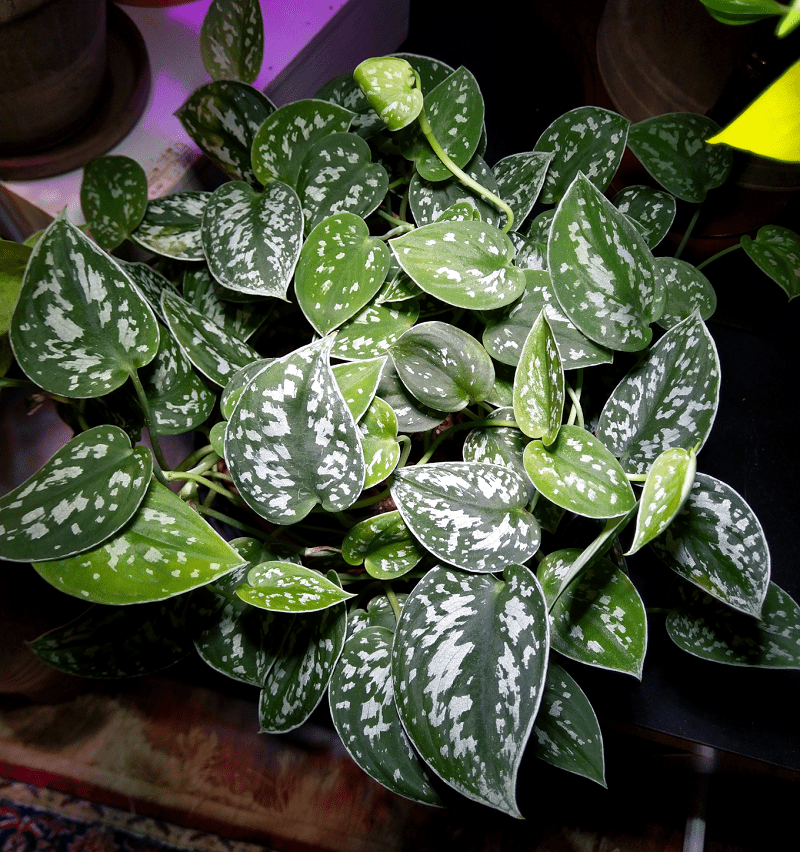Satin pothos (silver pothos) is rapidly garnering more attention from many houseplant enthusiasts across the country. Thanks to its dark green foliages with silver dots and splashes that foster lasting impressions.
Satin pothos care regime involves the provision of average humidity, bright indirect sunlight, regular watering, well-draining soil, and a temperature range of 65-85oF (18-29oC). Feed the silver pothos every month during the growing season.
This striking tropical plant is robust and requires minimal care routines. An appropriate care regime will result in successful tropical beauty growth. Continue reading this silver pothos care sheet to avoid guesswork.
You May Also Like: How to Grow and Care for Parlor Palm

What Does Satin Pothos Look Like?
The silk pothos hails from the tropical rainforest of Asia. The satin pothos has heart-shaped leaves, and the stems can reach 10ft long.
Indoor satin pothos has trailing stems that can grow up to 3ft long. Potted satin pothos requires regular pruning to foster compact shape and bushy appearance.
The dark green foliages with silver dots and splashes are the reason behind the silver satin pothos name. Scindapsus pictus “argyraeus”, “silver Ann” and “exotica” are the satin pothos cultivars.
Scindapsus pictus “argyraeus” has sparse silver variegation and Scindapsus pictus “exotica” has heavier silver splashes. The Scindapsus pictus “silver ann” has silver pothos leaves.
All these satin pothos varieties require similar care routines. An inappropriate care regime will result in satin pothos yellow leaves and other related problems.
The silver pothos foliages are toxic to pets and humans if ingested. Besides that, they can cause skin irritation on occasion. Keep the houseplant away from pets and children.
Satin Pothos Care Details
| Origin | Southeast Asia Rainforest |
| Scientific Name | Scindapsus pictus |
| Common Names | Silver pothos Satin pothos |
| Maximum Growth (Approx.) | 10ft long outdoor 3ft long indoor |
| Light Requirements | Bright indirect sunlight. The low light conditions will result in leaf markings. |
| Watering Needs | Water when 2-3 inches of topsoil is dry. Can tolerate under-watering and not overwatering. |
| Soil Requirements | Nutrients-rich and well-draining soil. |
| Temperature Range | 65-85oF (18-29oC) |
| Humidity Requirement | Above 40%. Use a digital hygrometer to monitor indoor humidity fluctuation. |
| Fertilizer Application | Apply water-soluble fertilizer every month during spring and summer. |
| Pruning Requirements | Regular pruning routine to control the size and shape of the plant. |
| Propagation | Stem cuttings in water or moist potting mix |
| Re-potting | Every 2-3 years during springtime. |
| Pests and Diseases | Pests: Spider mites and scales Diseases: Root rot due to overwatering |
| Toxicity | Poisonous to pets and humans. |
How to Care for Satin Pothos
Satin Pothos Soil Requirements
Silver pothos will do best in nutrient-rich potting soil with excellent drainage. Heavyweight potting soil will retain more water and become soggy in the long run.
A damp environment will make satin pothos suffer from root rot. Compact potting mix inhibits root aeration and water drainage.
Use an equal mix of peat, potting soil, and perlite to make a suitable satin pothos potting mix. Add compost to boost the potting soil fertility.
Soil drainage and nutrients are vital factors to consider when making or buying potting soil. They will help to aerate, nourish, and hydrate your tropical plant.
Satin Pothos Watering Needs
Satin pothos is a little bit forgiving when it comes to inconsistent watering habits. But overwatering can lead to unhealthy growing and potential plant death.
Water this tropical beauty when 2-3 inches of topsoil is dry. Insert the index finger in the potting soil to determine the moisture content.
Satin pothos leaves curling are signs of under-watering. Soak the potting soil to rehydrate the plant and allow the excess water to pass through the drainage holes.
Use room temperature water for your satin pothos. I recommend rainwater or distilled water to water the silver pothos. Allow tap water to sit overnight before watering your houseplant.
Satin Pothos Light Requirements
Satin pothos thrive in a location that receives bright indirect sunlight. Direct sunlight exposure will burn, fade, and wilt the leaves.
Low light conditions will result in unhealthy growth. The satin pothos leaves will begin losing the silver markings if the low light condition persists for an extended period.
The tropical houseplant can tolerate early morning or late evening sunlight. The sun rays’ intensity won’t harm your favorite houseplant.
Place the houseplant near the window that receives adequate sunlight. Ensure the window has curtains or shears to reduce the sun rays’ intensity.
Use artificial lights in rooms receiving low natural light. All the satin pothos cultivars will tolerate the artificial light without becoming fussy.
You May Also Read: How to Care for Stromanthe Triostar
Indoor Satin Pothos Temperature Needs
Scindapsus pictus is a tropical plant that prefers a warm and humid environment. Satin pothos will do best under a temperature range of 65-85oF (18-29oC).
Temperature below 60oF will make the satin pothos foliages suffer. Besides that, high temperature and low soil moisture will result in a droopy houseplant.
Use a digital thermometer to monitor the indoor temperature fluctuation. Try to maintain optimum temperature requirements for successful growth.
Humidity Requirements for Satin Pothos
The satin pothos native habitat is warm and humid. Every houseplant enthusiasts need to replicate the condition at home to produce healthy growth.
Ensure the indoor humidity level is above 40% for your satin pothos to thrive. Use an electric humidifier to boost the indoor humidity to meet the pothos requirements.
Another excellent option is to relocate the houseplant to the bathroom with lighting. The constant water use will result in a humid environment for the plant.
Satin pothos brown leaf tips and edges are signs of low humidity. Use a digital hygrometer to monitor the indoor humidity changes.
Satin Pothos Fertilizer Requirements
Nutrient-rich potting soil will foster vegetative and healthy growth. I recommend feeding your satin pothos with a water-soluble fertilizer every month during the growing season.
Do not fertilize the houseplant during winter. Dormancy and slow-growth rate will result in nutrient under-utilization. Besides that, it increases the risk of salt buildup around the roots.
Most commercial potting soil has slow-release fertilizer, so no need to apply an additional amount for several months. Satin pothos leaves turn yellow is a sign of nutritional deficiency.
Satin pothos leaves turning brown are a sign of over-fertilization. I recommend flushing the potting soil every 3-4 months to inhibit salt accumulation.
Satin Pothos Pruning Needs
Satin pothos has minimal pruning requirements. Use a sharp hand pruner to trim the plant if it’s growing long. It helps to control the size and enhance the bushy appearance.
Removing old or dead leaves also helps to facilitate tidiness. I recommend pruning your satin pothos during springtime and not winter or fall.
Sterilize the hand pruner to avoid spreading pests and diseases from other houseplants. Use Isopropyl alcohol to wipe the blades before trimming the houseplant.
Silver Satin Pothos Propagation
Stem cuttings are ideal for propagating the silver satin pothos. Cut the stem below the node and put it in a jar of water. Allow the stem to sit in water for a few weeks until the roots are about 1-inch.
Plant the stem in a pot with fresh potting mix. Ensure the potting soil is moist to encourage the juvenile roots to undertake their physiological activities.
How to Repot Satin Pothos
It is best to re-pot the silver splash pothos every 2-3 years during early spring. The silver satin pothos grows faster in a fresh and fertile potting mix.
Use a larger pot to accommodate the roots and keep the houseplant healthy. Slow-growth rate, roots poking through drainage holes, and poor drainages are signs of re-potting needs.
Remove the plant from the current pot without disrupting the root ball. Pour water on the roots to remove dirt and old soil. Inspect the roots for a sign of rot or damages.
Trim the old roots and fill the new container with appropriate potting soil. Plant the satin pothos and provide ultimate care for better growth.
You May Also Read: 22 Pothos Varieties with Names and Pictures
Satin Pothos Problems and Solutions
Pests
Spider mites and scales are the main types of household pests that cause a problem on silver satin pothos. Examine the foliages more often to determine any sign of bugs.
Use neem oil or insecticidal soap spray to eradicate these bugs from your houseplant. Undertake the task every week until all the bugs disappear.
Diseases
Satin pothos is less vulnerable to common plant diseases. But overwatering could result in root rot issues due to poor soil drainage and lack of drainage holes.
Stems turning brown and black spots on leaves are signs of root rot. Repot the houseplant to fresh and well-draining soil to revive it.
Besides that, overwatering and high humidity might trigger fungal growth. Develop a strict watering routine and provide better ventilation to combat fungal growth.
Frequently Asked Questions
Is Satin Pothos Toxic?
Yes. Silver satin pothos is poisonous to cats, dogs, and humans if ingested. Besides that, it causes skin irritation on occasions. Keep the houseplant away from kids and pets.
Why Is My Satin Pothos Leaves Curling?
Satin pothos leaves curl due to under-watering, overwatering, over-fertilization, and pest infestation. Investigate your houseplant to identify the exact cause and fix it.
Why Is My Satin Pothos Leaves Turning Yellow?
Inappropriate soil moisture and nutritional deficiency is the leading cause of satin pothos leaves turning yellow. Use water-soluble fertilizer to nourish your houseplant and reduce watering rate.
Why Is My Satin Pothos Leaves Turning Brown?
Satin pothos leaves turning brown are due to over-fertilization, under-watering, and low humidity. Other possible causes are extreme temperature and plant diseases.
You May Also Enjoy: How to Grow and Care for Calathea Makoyana

Final Thoughts
Satin pothos is a striking tropical plant relatively rare in many houseplant nurseries. The heart-shaped dark green foliages with silver dots and splashes tend to grab attention.
Grow your silver satin pothos in nutrient-rich draining soil and provide high humidity for healthy growth. Fertilize the houseplant every month during spring and summer.
I hope the information in this guide will empower you with the knowledge to grow healthy satin pothos. Silver satin pothos is easy to grow when you get the basics right.
